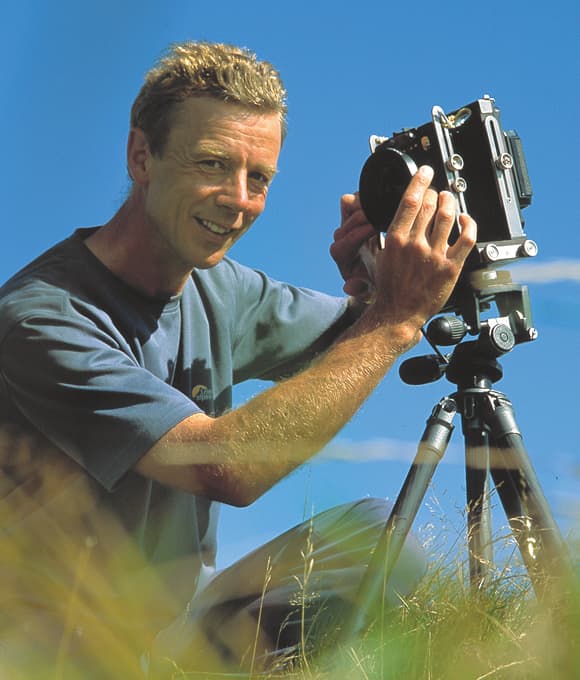
 It’s almost impossible to open a newspaper or turn on the TV these days without seeing some story about global warming – it’s clearly the single biggest issue facing the world at the moment. But how do you go about conveying it in a photograph? The challenge of photographing climate change was set to ten of the UK’s top photographers, including Joe Cornish, by the National Trust for a exhibition that toured the UK during the summer of 2007.
It’s almost impossible to open a newspaper or turn on the TV these days without seeing some story about global warming – it’s clearly the single biggest issue facing the world at the moment. But how do you go about conveying it in a photograph? The challenge of photographing climate change was set to ten of the UK’s top photographers, including Joe Cornish, by the National Trust for a exhibition that toured the UK during the summer of 2007.
The show, which was called ‘EXPOSED: Climate Change in Britain’s Backyard’, focused on the UK and brought together photographers from both the National Trust and Magnum Photos, including Joe Cornish, Simon Fraser, Paul Wakefield, Ian Berry, Mark Power and Chris Steele-Perkins.
Joe Cornish on Photographing climate change

An extraordinary amount of leaves in the canopy for the time of year, a sign of the complete Oak tree.
As Joe Cornish puts it, ‘My first thought when I was asked to participate was “How am I going to photograph that?” Photographers photograph weather, they don’t photograph climate. It’s a difficult concept to convey so you do need good captions to give the photographs context.
After some thought, Joe Cornish headed to Snowdonia to repeat a shot he had taken of the top of Glyder Fawr – some 2500ft above sea level – during the same month (January) some years before.
The resulting ‘before and after’ shots form arguably the most shocking and dramatic examples of climatic change in the exhibition.
‘Not that long ago that Glyder Fawr would usually have been completely covered in snow at that time of year, but over the last four or five winters it’s been a struggle to find scenes like that. The permanent snowline in Snowdonia simply isn’t there any more,’ Joe Cornish lament.

Living so close to the sea always poses the risk of flooding.
Joe Cornish’s pictures are certainly impressive, but they hardly convey the difficulties and effort involved in their creation. To get the most dramatic landscape photographs of the ridge meant being there either at sunrise or sunset, but this entailed either climbing or descending in darkness, while carrying a heavy backpack – a dangerous undertaking.
‘Glyder Fawr is very steep in parts,’ Joe Cornish explains. ‘It isn’t just a brisk walk, it’s a scramble. You have to use your hands to clamber up and over rocks. Doing that while carrying a 50lb pack plus a tripod isn’t easy even in daylight. The only alternative is to camp out overnight, but adding the tent, sleeping bag and food would probably add an extra 30kg to the weight, which would be exhausting.

A rise in water temperature has caused algae to form a mat on the river, depleting the water of oxygen.
Joe Cornish on Meeting the Brief
Despite his initial concerns anout meeting such an abstract brief Joe and the other photographers were able to supply the exhibition with a series of images that clearly show the effects of climate change on the UK. Here’s a selection, and the thinking behind them.
Joe Cornish’s Gear for photographing climate change
Digital technology is yet to make an impact in the area of large-format location photography, so it’s no surprise that Joe is still using his 5×4” Ebony camera loaded with Fuji film. ‘There are scanning backs available but they’re expensive and the exposure times are several minutes long even in good light. There are some American photographers using them and the quality is great but with light levels in the UK they aren’t really practical. Medium format backs are an alternative but they don’t offer a wide enough field of view for my needs.’
 When using large-format cameras, a sturdy tripod is essential but for the location photographer, weight is also a consideration. For Joe, the ideal compromise between strength and weight is found in his Gitzo G1327 Mountaineer carbon fibre tripod.‘Carbon fibre tripods are not only lighter than aluminium ones, but I believe they also offer a more stable, vibration-free platform. I also have a 1227 which is half the weight, which I sometimes use instead.’
When using large-format cameras, a sturdy tripod is essential but for the location photographer, weight is also a consideration. For Joe, the ideal compromise between strength and weight is found in his Gitzo G1327 Mountaineer carbon fibre tripod.‘Carbon fibre tripods are not only lighter than aluminium ones, but I believe they also offer a more stable, vibration-free platform. I also have a 1227 which is half the weight, which I sometimes use instead.’
The 1327 has now been replaced by a new model, the GT3550 and offers several enhancements, including anti-leg rotation, so all the locking collars can be released at once.
Joe Cornish usually carries his camera gear in a Lowepro Pro Trekker backpack, but has recently started using a Vertex 300 AW, which he is pretty impressed with.







